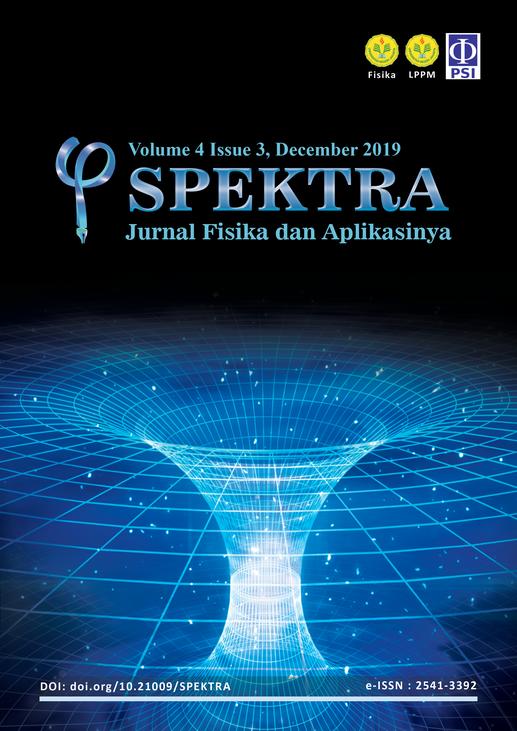BURIED WAVEGUIDE POLYMETHYLMETHACRYLATE MODELING FOR REFRACTIVE INDEX SENSOR APPLICATION USING FINITE ELEMENT METHOD
DOI:
https://doi.org/10.21009/SPEKTRA.043.04Keywords:
buried waveguide, refractive index sensor, finite element methodsAbstract
The purpose of this study is to obtain the optimum buried waveguide structure through modeling for refractive index sensor applications. The waveguide cladding material used as Polymethylmethacrylate (PMMA). The core cross-section size was 1 × 1 mm2. The simulation was carried out at a wavelength of 650 nm using the Finite Element Method (FEM). The parameter of the buried waveguide optimized in this model was the core refractive index and the thickness of the upper cladding to obtain a high propagation constant and good sensitivity to refractive index. Modeling was done for various core refractive index values varied in the range of 1.52 to 1.59, which are the refractive index of various types of polymers. To optimize the sensitivity, the thickness of the upper cladding was varied between 0.125mm to 0.5mm. Besides, a simulation was also carried out for a waveguide without an upper cladding. The results show that the optimum waveguide is a waveguide without upper cladding using polyester as core material with a refractive index value of 1.57 and a sensitivity of 4.9 × 10-10rad /m. RIU.
References
[2] X. Jiang and Q. Wang, “Refractive index sensitivity enhancement of optical fiber SPR sensor utilizing layer of MWCNT/PtNPs composite,” Opt. Fiber Technol., vol. 51, pp. 118–124, Sep. 2019.
[3] R. Nasirifar, M. Danaie, and A. Dideban, “Dual channel optical fiber refractive index sensor based on surface plasmon resonance,” Optik (Stuttg)., vol. 186, pp. 194–204, Jun. 2019.
[4] W. Du and F. Zhao, “Surface plasmon resonance based silicon carbide optical waveguide sensor,” Mater. Lett., vol. 115, pp. 92–95, Jan. 2014.
[5] G. C. Yadav et al., “Fabrication of a metal clad planar polymer waveguide based sensor for detection of low-refractive-index-contrast of liquid,” Optik (Stuttg)., vol. 138, pp. 289–294, Jun. 2017.
[6] Y. Chen, H. Ren, and T. Tang, “Optical-waveguide-based temperature sensor applied in intelligent buildings,” Opt. - Int. J. Light Electron Opt., vol. 124, no. 22, pp. 5628–5630, Nov. 2013.
[7] Y. Fan, Y. Ding, H. Ma, N. Teramae, S. Sun, and Y. He, “Optical waveguide sensor based on silica nanotube arrays for label-free biosensing,” Biosens. Bioelectron., vol. 67, pp. 230–236, May 2015.
[8] B. Hooda and V. Rastogi, “Low cost highly sensitive miniaturized refractive index sensor based on planar waveguide,” Optik (Stuttg)., vol. 143, pp. 158–166, Aug. 2017.
[9] I. Yulianti, N. M. D. P., Y. Lestiyanti and O. Kurdi, "Optimization of Ridge Waveguide Structure for Temperature Sensor Application Using Finite Difference Method," MATEC Web of Conferences, vol. 159, no. 02020, pp. 1-6, 2018.
[10] G. R. Liu and N. T. Trung, Smoothed Finite Element, Boca Raton: CRC Press, 2010.
[11] K. Peters, "Polymer optical fiber sensors-a review," Smart Materials and Structures, vol. 20, no. 013002, p. 17, 2011.
[12] Wang, M., Hiltunen, J. & Myllylä, R., 2013. Refractive index sensing in aqueous environment using three different polymeric waveguide interferometers. 3rd International Topical Meeting on Optical Sensing and Artificial Vision, pp. 166-171.
[13] Rezem, M. et al., 2016. Fabrication and sensing applications of multilayer polymer optical waveguides. Procedia Technology, Volume 26, pp. 517-523.
[14] Wang, L., Ren, K., Bao, S. & Kaixin, C., 2018. Highly Sensitive Refracive Index Sensor Based on Polymer Long-Period Waveguide Grating With Liquid Cladding. Photonic Sensors, pp. 1-6.
[15] Kim, J.-W., Kim, K.-J., Yi, J.-A. & Oh, M.-C., 2010. Polymer waveguide label-free biosensors with enhanced sensitivity by incorporating low-refractive-index polymers. IEEE Journal of Selected Topics in Quantum Electronics, 16(4), pp. 973-980.
[16] Khatri, A., Punjabi, N., Dhawangale, A. & Mukherji, S., 2016. Inexpensive polyester sheet based waveguides for detection of cardiac biomarker, myeloperoxidase. Procedia Engineering, Issue 168, pp. 125-128.
[17] Mishra, S. K., Zou, B. & Chiang, K. S., 2016. Surface-plasmon-resonance refractive-index sensor with Cu-coated polymer waveguide. IEEE Photonics Technology Letters, pp. 1-4.
[18] Boiragi, I. et al., 2009. SU-8 Polymer based waveguide biochemical sensor for medical diagnostic application. International Conference on Optics and Photonics, pp. 1-5
Downloads
Published
How to Cite
Issue
Section
License
SPEKTRA: Jurnal Fisika dan Aplikasinya allow the author(s) to hold the copyright without restrictions and allow the author(s) to retain publishing rights without restrictions. SPEKTRA: Jurnal Fisika dan Aplikasinya CC-BY or an equivalent license as the optimal license for the publication, distribution, use, and reuse of scholarly work. In developing strategy and setting priorities, SPEKTRA: Jurnal Fisika dan Aplikasinya recognize that free access is better than priced access, libre access is better than free access, and libre under CC-BY or the equivalent is better than libre under more restrictive open licenses. We should achieve what we can when we can. We should not delay achieving free in order to achieve libre, and we should not stop with free when we can achieve libre.
 SPEKTRA: Jurnal Fisika dan Aplikasinya is licensed under a Creative Commons Attribution 4.0 International License.
SPEKTRA: Jurnal Fisika dan Aplikasinya is licensed under a Creative Commons Attribution 4.0 International License.
You are free to:
Share - copy and redistribute the material in any medium or format
Adapt - remix, transform, and build upon the material for any purpose, even commercially.
The licensor cannot revoke these freedoms as long as you follow the license terms.

 E-ISSN 2541-3392
E-ISSN 2541-3392  Focus & Scope
Focus & Scope  Editorial Team
Editorial Team  Reviewer Team
Reviewer Team  Author Guidelines
Author Guidelines  Article Template
Article Template  Author Fee
Author Fee  Publication Ethics
Publication Ethics  Plagiarism Policy
Plagiarism Policy  Open Access Policy
Open Access Policy  Peer Review Process
Peer Review Process  Retraction & Correction
Retraction & Correction  Licensing & Copyright
Licensing & Copyright  Archiving & Repository
Archiving & Repository  Contact
Contact  Mendeley
Mendeley 

